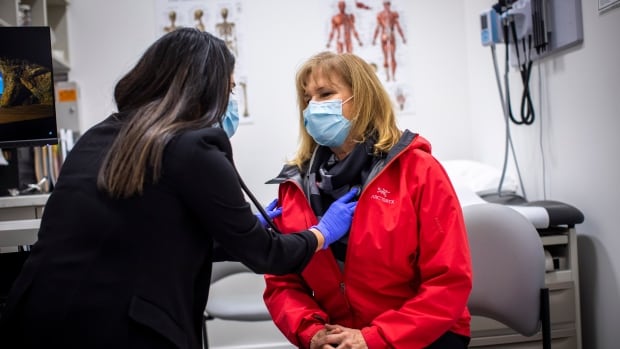
Most Canadian adults, 83 per cent, say they have access to a regular family doctor or nurse practitioner, according to a new report. But those with a dedicated provider may face lengthy waits, the report’s author says.
“The one thing that surprised me was the number of people who said that they had access to a regular health care provider,” said Kathleen Morris, vice president of research and analytics at Canadian Institute for Health Information (CIHI) in Toronto.
But, even those with a family doctor may have trouble getting in to see them without waiting weeks, said Morris.
“Some of it might be because people have more chronic conditions that take longer when they have a visit.”
Thursday’s report from CIHI the takes the pulse on shared priorities agreed to by federal, provincial and territorial governments in 2023. That includes:
- Increasing the supply of the health workforce and decreasing wait times for surgeries, which recovered to pre-pandemic levels.
- Improving access to mental health and substance use services.
- Modernizing health care information systems and digital tools for secure sharing of electronic health information.
In 2023, 5.4 million (17 per cent) Canadians aged 18 and older didn’t have access to a regular health care provider, such as a family doctor, general practitioner, medical specialist or nurse practitioner, according to the report.
Family doctors and nurse practitioners are considered the “lynchpin” in managing health-care services, Morris said.
Morris said provinces have different models to make sure people get front-line care, such as team-based care for those newly diagnosed with diabetes where a doctor works with a nurse and dietitian to get someone’s blood sugar levels under control.
No room for complacency
Overall, Dr. Raghu Venugopal, an emergency doctor in Toronto, said the progress report on Canadian health care amounts to an A-minus grade with “trudging steps of progress.”
Venugopal, who works evenings and overnight at three urban hospitals, said a “concerning minority” of patients he sees may not have a family doctor or one who is accessible to follow up after he applies stitches to get them removed.
“I don’t think anyone … is complacent about the improvements that we have to make, especially in primary care,” Venugopal said. “The reality is that if family medicine and primary care is strong, that strengthens all of medicine.”
A Canadian Medical Association report is calling on governments to provide half of all Canadians with access to a family doctor within five years, to cover costs in another province if wait times are too long and to clamp down on membership fees at private clinics.
Wild goose chase for health care
Jenna Kedy, 20, of Halifax was diagnosed with rheumatoid arthritis as a child. More recently, she was diagnosed with fibromyalgia, a chronic pain condition, and had a bout of pneumonia in May.
Kedy, who is a patient partner with CIHI, has a complicated medical history and hasn’t had a consistent family doctor for the past two years.
“It was a really scary time in my life having those symptoms,” Kedy recalled. “I remember doing the wild goose chases and going to two or three hospitals over a number of days before I was actually able to get seen and supported, which is really unfortunate because that has caused a lot of frustration, mental health stress, and even times where I feel so defeated.”

Almost all provinces and territories had a net increase in the number of family physicians (2021–2022), nurses and nurse practitioners (2022) compared with the year prior.
But family physicians are on average seeing fewer patients per year, from 1,746 in 2013 to 1,353 in 2021, CIHI previously reported.
“One of the benefits of having good data and having comparable measurements across the country is that the provinces can learn from each other,” Morris said.
CIHI plans to develop indicators and measurements in more specific areas, such as treatment for substance use disorders, in future reports.
